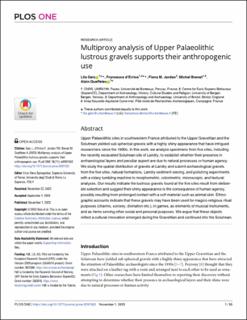| dc.contributor.author | Geis, Lila | |
| dc.contributor.author | d'Errico, Francesco | |
| dc.contributor.author | Jordan, Fiona | |
| dc.contributor.author | Brenet, Michel | |
| dc.contributor.author | Queffelec, Alain | |
| dc.date.accessioned | 2024-03-15T12:09:07Z | |
| dc.date.available | 2024-03-15T12:09:07Z | |
| dc.date.created | 2023-11-14T18:36:02Z | |
| dc.date.issued | 2023 | |
| dc.identifier.issn | 1932-6203 | |
| dc.identifier.uri | https://hdl.handle.net/11250/3122629 | |
| dc.description.abstract | Upper Palaeolithic sites in southwestern France attributed to the Upper Gravettian and the Solutrean yielded sub spherical gravels with a highly shiny appearance that have intrigued researchers since the 1930s. In this work, we analyze specimens from five sites, including the recently excavated Solutrean site of Landry, to establish whether their presence in archaeological layers and peculiar aspect are due to natural processes or human agency. We study the spatial distribution of gravels at Landry and submit archaeological gravels from the five sites, natural formations, Landry sediment sieving, and polishing experiments with a rotary tumbling machine to morphometric, colorimetric, microscopic, and textural analyses. Our results indicate the lustrous gravels found at the five sites result from deliberate selection and suggest their shiny appearance is the consequence of human agency, possibly resulting from prolonged contact with a soft material such as animal skin. Ethnographic accounts indicate that these gravels may have been used for magico-religious ritual purposes (charms, sorcery, divination etc.), in games, as elements of musical instruments, and as items serving other social and personal purposes. We argue that these objects reflect a cultural innovation emerged during the Gravettian and continued into the Solutrean. | en_US |
| dc.language.iso | eng | en_US |
| dc.publisher | PLoS | en_US |
| dc.rights | Navngivelse 4.0 Internasjonal | * |
| dc.rights.uri | http://creativecommons.org/licenses/by/4.0/deed.no | * |
| dc.title | Multiproxy analysis of Upper Palaeolithic lustrous gravels supports their anthropogenic use | en_US |
| dc.type | Journal article | en_US |
| dc.type | Peer reviewed | en_US |
| dc.description.version | publishedVersion | en_US |
| dc.rights.holder | Copyright 2023 The Author(s) | en_US |
| dc.source.articlenumber | e0291552 | en_US |
| cristin.ispublished | true | |
| cristin.fulltext | original | |
| cristin.qualitycode | 1 | |
| dc.identifier.doi | 10.1371/journal.pone.0291552 | |
| dc.identifier.cristin | 2196721 | |
| dc.source.journal | PLOS ONE | en_US |
| dc.relation.project | Norges forskningsråd: 262618 | en_US |
| dc.identifier.citation | PLOS ONE. 2023, 18 (11), e0291552. | en_US |
| dc.source.volume | 18 | en_US |
| dc.source.issue | 11 | en_US |

